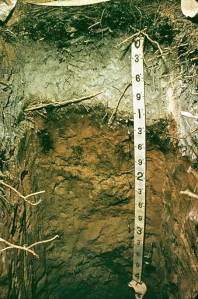Question: When soil scientists dig a big hole to examine the soil, what are they looking for exactly?
Answer: Soil scientists are looking for several things when they examine the soil exposed in a hole–or, as soil scientists like to call it–a soil pit.
A soil scientist wants to establish which layers, or horizons (designated O, A, E, B, C, and/or R), exist in a given soil, as well as the depth and thicknesses of those horizons. These horizons are established based on differences in properties like soil color, texture (the combination of sand, silt, and clay that makes up the mineral portion of soil), organic content, and structure (the arrangement of sand, silt, and clay particles into regular shapes).
Differences in color (see the photo above) are one of the most obvious criteria that differentiate soil horizons. See the blog entry on soil color for more information on what causes the different colors in soils.

Soil scientists are also interested in things like root content and differences with depth/horizon; rock fragments larger than sand size; pores that are found within and between the soil structural units; the pH of the various horizons; and if the soil contains one or more of various salts that are fairly common in some soils.
All of this information can be used to determine the uses to which soil is well suited, as well as limitations to the use of that soil.
–Answered by Eric Brevik, Dickinson State University
Have a question for Soils Matter? Post it as a comment below, or email us at soils-matter@soils.org.


Reblogged this on Blessed.